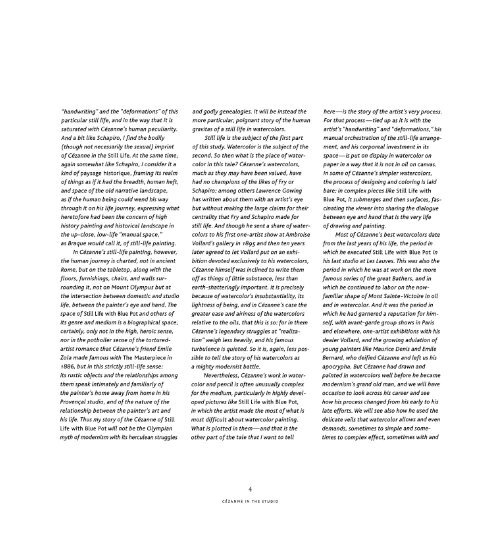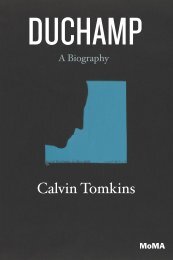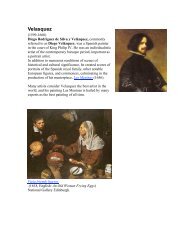Still Life in Watercolors
qbj8dgc
qbj8dgc
- No tags were found...
You also want an ePaper? Increase the reach of your titles
YUMPU automatically turns print PDFs into web optimized ePapers that Google loves.
"handwrit<strong>in</strong>g" and the "deformations" of this<br />
particular still life, and <strong>in</strong> the way that it is<br />
saturated with Cezanne's human peculiarity.<br />
And a bit like Schapiro, I f<strong>in</strong>d the bodily<br />
(though not necessarily the sexual) impr<strong>in</strong>t<br />
of Cezanne <strong>in</strong> the <strong>Still</strong> <strong>Life</strong>. At the same time,<br />
aga<strong>in</strong> somewhat like Schapiro, I consider it a<br />
k<strong>in</strong>d o/paysage historique, fram<strong>in</strong>g its realm<br />
of th<strong>in</strong>gs as if it had the breadth, human heft,<br />
and space of the old narrative landscape,<br />
as if the human be<strong>in</strong>g could wend his way<br />
through it on his life journey, express<strong>in</strong>g what<br />
heretofore had been the concern of high<br />
history pa<strong>in</strong>t<strong>in</strong>g and historical landscape <strong>in</strong><br />
the up-close, low-life "manualspace,"<br />
as Braque would call it, of still-life pa<strong>in</strong>t<strong>in</strong>g.<br />
In Cezanne's still-life pa<strong>in</strong>t<strong>in</strong>g, however,<br />
the human journey is charted, not <strong>in</strong> ancient<br />
Rome, but on the tabletop, along with the<br />
floors, furnish<strong>in</strong>gs, chairs, and walls surround<strong>in</strong>g<br />
it, not on Mount Olympus but at<br />
the <strong>in</strong>tersection between domestic and studio<br />
life, between the pa<strong>in</strong>ter's eye and hand. The<br />
space of <strong>Still</strong> <strong>Life</strong> with Blue Pot and others of<br />
its genre and medium is a biographical space,<br />
certa<strong>in</strong>ly, only not <strong>in</strong> the high, heroic sense,<br />
nor <strong>in</strong> the potboiler sense of the torturedartist<br />
romance that Cezanne's friend Emile<br />
Zola made famous with The Masterpiece <strong>in</strong><br />
1886, but <strong>in</strong> this strictly still-life sense:<br />
its rustic objects and the relationships among<br />
them speak <strong>in</strong>timately and familiarly of<br />
the pa<strong>in</strong>ter's home away from home <strong>in</strong> his<br />
Provencal studio, and of the nature of the<br />
relationship between the pa<strong>in</strong>ter's art and<br />
his life. Thus my story of the Cezanne of <strong>Still</strong><br />
<strong>Life</strong> with Blue Pot will not be the Olympian<br />
myth of modernism with its herculean struggles<br />
and godly genealogies. It will be <strong>in</strong>stead the<br />
more particular, poignant story of the human<br />
gravitas of a still life <strong>in</strong> watercolors.<br />
<strong>Still</strong> life is the subject of the first part<br />
of this study. Watercolor is the subject of the<br />
second. So then what is the place of watercolor<br />
<strong>in</strong> this tale? Cezanne's watercolors,<br />
much as they may have been valued, have<br />
had no champions of the likes of Fry or<br />
Schapiro; among others Lawrence Cow<strong>in</strong>g<br />
has written about them with an artist's eye<br />
but without mak<strong>in</strong>g the large claims for their<br />
centrality that Fry and Schapiro made for<br />
still life. And though he sent a share of watercolors<br />
to his first one-artist show atAmbroise<br />
Vollard's gallery <strong>in</strong> 7895 and then ten years<br />
later agreed to let Vollard put on an exhibition<br />
devoted exclusively to his watercolors,<br />
Cezanne himself was <strong>in</strong>cl<strong>in</strong>ed to write them<br />
off as th<strong>in</strong>gs of little substance, less than<br />
earth-shatter<strong>in</strong>gly important. It is precisely<br />
because ofwatercolor's <strong>in</strong>substantiality, its<br />
lightness of be<strong>in</strong>g, and <strong>in</strong> Cezanne's case the<br />
greater ease and air<strong>in</strong>ess of the watercolors<br />
relative to the oils, that this is so: for <strong>in</strong> them<br />
Cezanne's legendary struggles at "realization"<br />
weigh less heavily, and his famous<br />
turbulence is quieted. So it is, aga<strong>in</strong>, less possible<br />
to tell the story of his watercolors as<br />
a mighty modernist battle.<br />
Nevertheless, Cezanne's work <strong>in</strong> watercolor<br />
and pencil is often unusually complex<br />
for the medium, particularly <strong>in</strong> highly developed<br />
pictures like <strong>Still</strong> <strong>Life</strong> with Blue Pot<br />
<strong>in</strong> which the artist made the most of what is<br />
most difficult about watercolor pa<strong>in</strong>t<strong>in</strong>g.<br />
What is plotted <strong>in</strong> them—and that is the<br />
other part of the tale that I want to tell<br />
here—is the story of the artist's very process.<br />
For that process—tied up as it is with the<br />
artist's "handwrit<strong>in</strong>g"and "deformations,"his<br />
manual orchestration of the still-life arrangement,<br />
and his corporeal <strong>in</strong>vestment <strong>in</strong> its<br />
space—is put on display <strong>in</strong> watercolor on<br />
paper <strong>in</strong> a way that it is not <strong>in</strong> oil on canvas.<br />
In some of Cezanne's simpler watercolors,<br />
the process of design<strong>in</strong>g and color<strong>in</strong>g is laid<br />
bare; <strong>in</strong> complex pieces like <strong>Still</strong> <strong>Life</strong> with<br />
Blue Pot it submerges and then surfaces, fasc<strong>in</strong>at<strong>in</strong>g<br />
the viewer <strong>in</strong>to shar<strong>in</strong>g the dialogue<br />
between eye and hand that is the very life<br />
of draw<strong>in</strong>g and pa<strong>in</strong>t<strong>in</strong>g.<br />
Most of Cezanne's best watercolors date<br />
from the last years of his life, the period <strong>in</strong><br />
which he executed <strong>Still</strong> <strong>Life</strong> with Blue Pot <strong>in</strong><br />
his last studio at Les Lauves. This was also the<br />
period <strong>in</strong> which he was at work on the more<br />
famous series of the great Bathers, and <strong>in</strong><br />
which he cont<strong>in</strong>ued to labor on the nowfamiliar<br />
shape of Mont Sa<strong>in</strong>te-Victoire <strong>in</strong> oil<br />
and <strong>in</strong> watercolor. And it was the period <strong>in</strong><br />
which he had garnered a reputation for himself,<br />
with avant-garde group shows <strong>in</strong> Paris<br />
and elsewhere, one-artist exhibitions with his<br />
dealer Vollard, and the grow<strong>in</strong>g adulation of<br />
young pa<strong>in</strong>ters like Maurice Denis and Emile<br />
Bernard, who deified Cezanne and left us his<br />
apocrypha. But Cezanne had drawn and<br />
pa<strong>in</strong>ted <strong>in</strong> watercolors well before he became<br />
modernism's grand old man, and we will have<br />
occasion to look across his career and see<br />
how his process changed from his early to his<br />
late efforts. We will see also how he used the<br />
delicate veils that watercolor allows and even<br />
demands, sometimes to simple and sometimes<br />
to complex effect, sometimes with and<br />
4<br />
CEZANNE IN THE STUDIO




